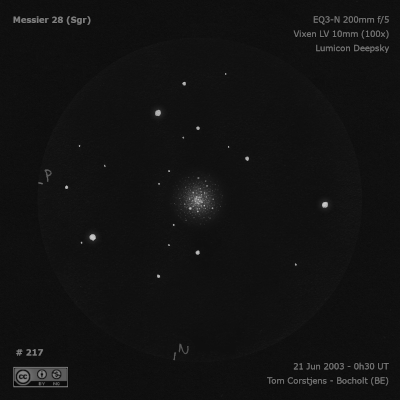
Charles Messier discovered M28 = NGC 6626 = h2010 = h3743 on 27 July 1764. WH first observed this globular on 4 Jul 1783 with his 12-inch (small 20-foot) and noted "if the night were clearer I double not of its being stars that might be seen very distinctly." On 12 Jul 1784 (sweep 236) he logged "A cl of exceedingly compressed stars, vBM, R, with 3 or 4 small, irregular branches. The large stars red."
JH recorded (sweep 474 from the CGH) "globular; vB; R; vm comp; gbM, but not to a nipple; diam in RA = 12 seconds; resolved into st 14...16m; a fine object. Occurs in the milky way, of which the stars here are barely visible and immensely numerous."
200/250mm - 8" (7/16/82): bright, sharp concentration, lively halo just resolves into many faint stars at 200x!
300/350mm - 13.1" (6/29/84): a prominent star chain extends to the north.
13.1" (7/16/82): very bright, fairly large, sharp concentration with a lively unresolved core. A few stars are resolved at the edges of the core over haze and many stragglers resolved including long spidery chains. A total of a few dozen stars resolved. Excellent view at 290x and a star chain to the north is prominent.
400/500mm - 17.5" (7/10/99): striking globular at 220x, with the halo appearing ~4.5' in diameter and a very bright core ~2'x1.5' elongated SSW-NNE. Extensive resolution at 280x and 380x with roughly 50 stars resolved in the halo. At 380x the edges of the core really start breaking up into numerous stars and a rich sprinkling of stars is superimposed on the well-defined core. On the north side of the halo a long star chain heads directly north and a fainter but richer chain starts to trail off the east side of the core but abruptly turns in a chain heading NNW.
Notes by Steve Gottlieb